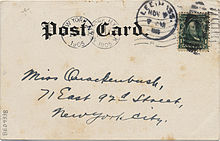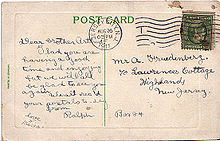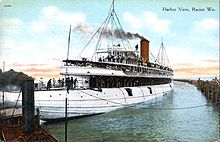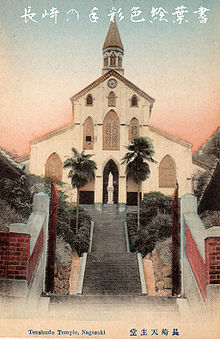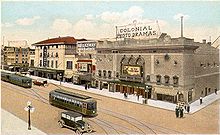- Postcard
-
For the computer diagnostic tool, see POST card. For the record label, see Postcard Records. For the song by The Huntingtons, see Self-Titled Album (The Huntingtons album). For the 2010 Japanese film, see Postcard (film).
A postcard or post card is a rectangular piece of thick paper or thin cardboard intended for writing and mailing without an envelope.[1]
In some places, it is possible to send them for a lower fee than for a letter. Stamp collectors distinguish between postcards (which require a stamp) and postal cards (which have the postage pre-printed on them). While a postcard is usually printed by a private company, individual or organization, a postal card is issued by the relevant postal authority. The United States Postal Service defines a postcard as: rectangular, at least 31⁄2 inches (88.9 mm) high × 5 inches (127 mm) long × 0.007 inches (0.178 mm) thick and no more than 41⁄4 inches (108 mm) high × 6 inches (152.4 mm) long × 0.016 inches (0.406 mm) thick.[2] However, some postcards have deviated from this (for example, shaped postcards).
The study and collecting of postcards is termed deltiology.
Contents
Early history of postcards
Cards with messages had been sporadically created and posted by individuals since the creation of postal services. The earliest known picture postcard was a hand-painted design on card, posted in London to the writer Theodore Hook in 1840 bearing a penny black stamp. He probably created and posted the card to himself as a practical joke on the postal service, since the image is a caricature of workers in the post office.[3][4]
In the United States, a picture or blank card stock that held a message and sent through the mail at letter rate first began when a card postmarked in December of 1848 contained printed advertising on it.[5] The first commercially produced card was created in 1861 by John P. Charlton of Philadelphia, who patented a postal card, selling the rights to Hymen Lipman, whose postcards, complete with a decorated border, were labeled "Lipman's postal card." These cards had no images.
In Britain postcards without images were issued by Post Office, and were printed with a stamp as part of the design, which was included in the price of purchase. The first known printed picture postcard, with an image on one side, was created in France in 1870 at Camp Conlie by Léon Besnardeau (1829–1914). Conlie was a training camp for soldiers in the Franco-Prussian war. They had a lithographed design printed on them containing emblematic images of piles of armaments on either side of a scroll topped by the arms of the Duchy of Brittany and the inscription "War of 1870. Camp Conlie. Souvenir of the National Defence. Army of Brittany".[6] While these are certainly the first known picture postcards, there was no space for stamps and no evidence that they were ever posted without envelopes.[7]
In the following year the first known picture postcard in which the image functioned as a souvenir was sent from Vienna.[8] The first advertising card appeared in 1872 in Great Britain and the first German card appeared in 1874. Cards showing images increased in number during the 1880s. Images of the newly built Eiffel Tower in 1889 and 1890 gave impetus to the postcard, leading to the so-called "golden age" of the picture postcard in years following the mid-1890s.
Early US postcards
The first American postcard was developed in 1873 by the Morgan Envelope Factory of Springfield, Massachusetts. [9] [10] Later in 1873, Post Master John Creswell introduced the first pre-stamped "penny postcards". These first postcards depicted Interstate Industrial Exposition that took place in Chicago.[11] Postcards were made because people were looking for an easier way to send quick notes. The first postcard to be printed as a souvenir in the United States was created in 1893 to advertise the World's Columbian Exposition in Chicago.
The Post Office was the only establishment allowed to print postcards, and it held its monopoly until May 19, 1898, when Congress passed the Private Mailing Card Act which allowed private publishers and printers to produce postcards. Initially, the United States government prohibited private companies from calling their cards "postcards", so they were known as "souvenir cards". These cards had to be labeled "Private Mailing Cards". This prohibition was rescinded on December 24, 1901, when private companies could use the word "postcard". Postcards were not allowed to have a divided back and correspondents could only write on the front of the postcard. This was known as the "undivided back" era of postcards. On March 1, 1907 the Post Office allowed private citizens to write on the address side of a postcard. It was on this date that postcards were allowed to have a "divided back".[11]
On these cards the back is divided into two sections, the left section being used for the message and the right for the address. Thus began the Golden Age of American postcards, which lasted until 1915, when World War I blocked the import of the fine German-printed cards.
Postcards, in the form of government postal cards and privately printed souvenir cards, became very popular as a result of the Columbian Exposition, held in Chicago in 1893, after postcards featuring buildings were distributed at the fair. In 1908, more than 677 million postcards were mailed.
The "white border" era, named for obvious reasons, lasted from about 1916 to 1930. The "linen card" era lasted from about 1931 to the early 1950s, when cards were primarily printed on papers with a textured surface similar to linen cloth. The last and current postcard era, which began about 1939, is the "chrome" era, however these types of cards did not begin to dominate until about 1950. The images on these cards are generally based on colored photographs, and are readily identified by the glossy appearance given by the paper's coating.
In 1973 the British Post Office introduced a new type of card, PHQ Cards, popular with collectors, especially when they have the appropriate stamp affixed and a First day of issue postmark obtained.
Postcards in British India
In July 1879, the Post Office of India introduced a 1/4 anna postcard which provided postage from one place to another within British India. This was the cheapest form of post provided to the Indian people to date and proved a huge success. The establishment of a large postal system spanning India resulted in unprecedented postal access where a message on a postcard could be sent from one part of the country to another part (often to a physical address without a nearby post office) without additional postage affixed. This was followed in April 1880 by postcards meant specifically for government use and by reply post cards in 1890.[12]:423-424 The postcard facility continues to this date in independent India.
British seaside postcards
In 1894, British publishers were given permission by the Royal Mail to manufacture and distribute picture postcards, which could be sent through the post. The first UK postcards were produced by printing firm Stewarts of Edinburgh and early postcards were pictures of famous landmarks, scenic views, photographs or drawings of celebrities and so on. With steam locomotives providing fast and affordable travel, the seaside became a popular tourist destination, and generated its own souvenir-industry: the picture postcard was, and is, an essential staple of this industry.
In the early 1930s, cartoon-style saucy postcards became widespread, and at the peak of their popularity the sale of saucy postcards reached a massive 16 million a year. They were often bawdy in nature, making use of innuendo and double entendres and traditionally featured stereotypical characters such as vicars, large ladies and put-upon husbands, in the same vein as the Carry On films. In the early 1950s, the newly elected Conservative government were concerned at the apparent deterioration of morals in Britain and decided on a crackdown on these postcards. The main target on their hit list was the renowned postcard artist Donald McGill. In the more liberal 1960s, the saucy postcard was revived and became to be considered, by some[who?], as an art form. This helped its popularity and once again they became an institution. However, during the 1970s and 1980s, the quality of the artwork and humour started to deteriorate and, with changing attitudes towards the cards' content, the demise of the saucy postcard occurred. Original postcards are now highly sought after, and rare examples can command high prices at auction. The best-known saucy seaside postcards were created by a publishing company called Bamforths, based in the town of Holmfirth, West Yorkshire, England. Despite the decline in popularity of postcards that are overtly 'saucy', postcards continue to be a significant economic and cultural aspect of British seaside tourism. Sold by newsagents and street vendors, as well as by specialist souvenir shops, modern seaside postcards often feature multiple depictions of the resort in unusually favourable weather conditions. John Hinde, the British photographer, used saturated colour and meticulously planned his photographs, which made his postcards of the later twentieth century become collected and admired as kitsch. Such cards are also respected as important documents of social history, and have been influential on the work of Martin Parr.
Controversy
The initial appearance of picture postcards (and the enthusiasm with which the new medium was embraced) raised some legal issues. Picture postcards allowed and encouraged many individuals to send images across national borders, and the legal availability of a postcard image in one country did not guarantee that the card would be considered "proper" in the destination country, or in the intermediate countries that the card would have to pass through. Some countries might refuse to handle postcards containing sexual references (in seaside postcards) or images of full or partial nudity (for instance, in images of classical statuary or paintings).[13]
In response to this new phenomenon, the Ottoman Empire banned the sale or importation of some materials relating to the Islamic prophet Muhammad in 1900. Affected postcards that were successfully sent through the OE before this date (and are postmarked accordingly) have a high rarity value and are considered valuable by collectors.
Glossary of postcard terms
3 D postcard - 1970's
- Appliqué
- A term used to describe a postcard which has some form of cloth, metal or other embellishment attached to it.
- Art Déco
- Artistic style of the 1920s, recognisable by its symmetrical designs and straight lines.
- Art Nouveau
- Artistic style of the turn of the century, characterised by flowing lines and flowery symbols, yet often depicting impressionist more than representational art.
- Artist Signed
- Postcards with artwork that has the artist's signature, and the art is often unique for postcards.
- Bas Relief
- Postcards with a heavily raised surface, giving a papier-mâché appearance.
- Big Letter
- A term used to describe a postcard that shows the name of a place in very big letters that do not have pictures inside each letter (see also Large Letter).
- Composites
- A number of individual cards, that when placed together in a group, form a larger picture. Also called "installment" cards.
- Court Cards
- The official size for British postcards between 1894–1899, measuring 115 × 89 mm (4.5 × 3.5 in).
- Divided Back
- Postcards with a back divided into two sections, one for the message, the other for the address. British cards were first divided in 1902 and American cards in 1907.
- Django Fontina
- A postcard written to a stranger, typically as a means of disseminating poetry.
- Early
- A term loosely used to describe any card issued before the Divided Back was introduced.
- Embossed
- Postcards with a raised surface.
- Hand-tinted
- Black-and-white images were tinted by hand using watercolours and stencils.
- Hold-to-Light
- Also referred to as ‘HTL’, postcards often of a night time scene with cut out areas to show the light.
- Intermediate Size
- The link between Court Cards and Standard Size, measuring 130 × 80 mm (5.1 × 3.1 in).
- Kaleidoscopes
- Postcards with a rotating wheel that reveals a myriad of colours when turned.
- Large Letter
- A term used to describe a postcard which has the name of a place shown as a series of very large letters, inside of each of which is a picture of that locale (see also Big Letter).
- Midget Postcards
- Novelty cards of the size 90 × 70 mm (3.54 × 2.76 in).
- Novelty
- Any postcard which deviates in any way from the norm. Cards which do something, or have articles attached to them, or are printed in an unusual size or on strange materials. An example is cards made of leather.
- Oilette
- A trade name used by Raphael Tuck & Sons to describe postcards reproduced from original paintings.
- Postcardese
- The style of writing used on postcards; short sentences, jumping from one subject to another.
- Real Photographic
- Abbreviated to ‘RP’. Used to describe postcards produced by a photographic rather than a printing process.
- Reward Cards
- Cards that were given away to school children for good work.
- Standard Size
- Introduced in Britain in November 1899, measuring 140 × 89 mm (5.5 × 3.5 in).
- Topographical
- A term used to describe postcards showing street scenes and general views. Judges Postcards produced many British topographical views.
- Undivided Back
- Describes postcards with a plain back where all of this space was used for the address. This is a term often used to describe Early cards, although undivided were still in common use up until 1907.
- Vignette
- Usually found on undivided back cards, consisting of a design which does not occupy the whole of the picture side. Vignettes may be anything from a small sketch in one corner of the card, to a design cover three quarters of the card. The purpose is to leave some space for the message to be written, as the entire reverse of the card could only be used for the address.
- Write-Away
- Used to describe a card with the opening line of a sentence, which the sender would then complete. Often found on early comic cards.
See also
- Advertising postcard
- Chicago Postcard Museum
- Deltiology
- e-card
- Ellen Clapsaddle
- Esther Howland
- Frances Brundage
- Francis Frith
- Greeting card
- James Valentine
- F.G.O Stuart
- Judges Postcards
- Mail Art
- Paper sizes
- PHQ Cards
- Postal card
- Postcardware
- Postcrossing
- Postino
- PostSecret
- QSL card
- Real photo postcard
- Touchnote mobile phone postcards
References
- ^ There have been some exceptions to this, such as postcards made of thin wood, and copper postcards are widely sold in the Copper Country of the U.S. state of Michigan.
- ^ "USPS - Mail Characteristics - Sizes for Cards". USPS. Archived from the original on 2008-01-20. http://web.archive.org/web/20080120115502/http://www.usps.com/businessmail101/mailcharacteristics/cards.htm. Retrieved 2 June 2011.
- ^ Arifa Akbar, "Oldest picture postcard in the world snapped up for £31,750", The Independent, 9 March 2002.
- ^ BBC news
- ^ "Pre History of the Postcard 1848-1872". Metropolitan Postcard Club of New York City. http://www.metropostcard.com/history1848-1872.htm.
- ^ The New York Times, September 21, 1904.
- ^ http://www.cartolis.org/histoire.php Histoire de la Carte Postale, Cartopole, Baud.
- ^ Frank Staff, The Picture Postcard & Its Origins, New York: F.A. Praeger, p.51.
- ^ http://www.bostonhistorycollaborative.org/bostoninnovation/breakthroughs.htm
- ^ http://springfield375.org/
- ^ a b "The History of Postcards". http://www.emotionscards.com/museum/historyofpostcards.htm.
- ^ The Imperial Gazetteer of India. (1908). Vol 3 (Economic), p. 424
- ^ For example, the United States Postal Service would only allow the delivery of postcards showing a back view of naked men from Britain if their posteriors were covered with a black bar. "Naked film postcards returned to sender" (in English) BBC News 30 July 2001 http://news.bbc.co.uk/2/hi/uk_news/wales/1464627.stm. Retrieved 2011-06-05
http://www.abadie.co.uk/postcards (currently the only book of classic John Hinde postcards with the senders messages transcribed)
http://www.johnhindecollection.com (a website dedicated to John Hinde Postcards)
External links
- Chicago Postcard Museum -- A complete collection of the 1st postcards produced in the U.S.
- The Postcard Traders association -- Represents professionals within the UK postcard industry.
Categories:- British comedy and humour
- British culture
- Postcards
- Postal stationery
- Philatelic terminology
Wikimedia Foundation. 2010.



